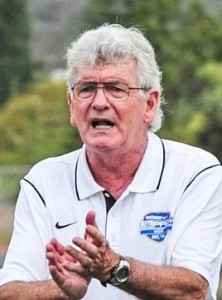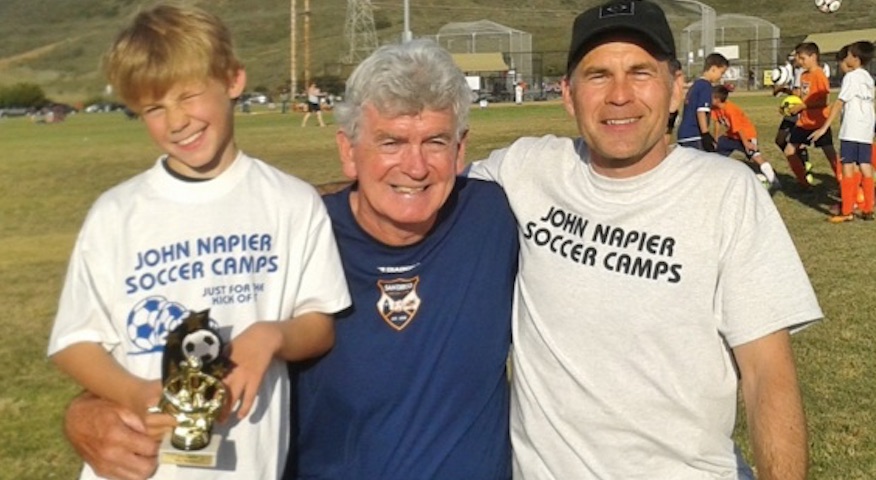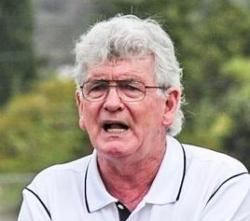John Napier on – Interviews Dr. Gunther Karsten
John Napier is a former professional soccer player who represented his country of birth Northern Ireland at every International level. He had a distinguished seventeen year professional playing career, starting with Bolton Wanderers in 1961-67. Napier also played for Brighton & Hove Albion and Bradford City in England as well as the NASL in America for the Baltimore Comets and the San Diego Jaws. Napier has coached at the professional level in England, and since the 70’s, the multiple time MVP Napier has shared his expertise developing youth players. A highly respected youth soccer coach, Napier coaches with the San Diego Soccer Club and also identifies players, and coaches for Cal South ODP and has had numerous National Championship winning teams. Napier is a regular columnist sharing his insights on player development and the joys of soccer.
 |
Recently, I had the tremendous pleasure of having a young German soccer player train twice with my San Diego Soccer Club (SDSC) BU10 team and also attend one of our skills clinics. The young player, Dan, was very talented and fitted right in with my “new” SDSC team this year, BU10.
I was very interested to find out about the German culture and the environment that young Dan played in each week in his soccer-crazy country. This research all started a few weeks before their arrival in April for a stay in California and Nevada, as well as seeing an old college soccer friend from Colorado.
Dr. Gunther Karsten, Dan’s father, emailed Brian Quinn, our Director of Coaching at SDSC. Brian then put him in touch with me, as they were staying in the area. We had good conversations through email before they arrived, and it was great to have a young player from a different country practice with my boys.
As a youth coach, I was interested to see the comparison between the boys, and Dan was definitely in the top 5% of the current players on my roster.
I wanted to find out more about youth soccer in Germany, so I had many conversations with Gunther. I found out he had a soccer background in Germany as a youth professional player, and had attended College in Colorado, as well as written a soccer book, Soccer Smarts. He and I also share the same birth date, but I can give him quite a few years on that one.
He was enthralled with my practice sessions and their purpose, and the first-hand look at the way we teach the game to his son’s age group. Afterwards Gunther presented me with a signed copy of his soccer book, with some great comments on my practice sessions with his boy.
Dr. Karsten is an eight-time German memory champion, 2007 World Memory Champion, World record-holder and 18 time World Champion in various disciplines within the memory sport. Due to his extraordinary powers, in 1999 he was nominated for “Brain of the Year Award” alongside notable personalities Bill Gates and Steven Spielberg.
For more information on Dr. Gunther Karsten please read his Bio. Unfortunately his book Soccer Smarts has yet to get a publisher in the U.S., but his best-selling book Brighter can be ordered in English on www.amazon.com
I asked Gunther the following soccer questions, and after his return to Germany he replied to all my questions in detail. I am selfishly hoping that he and his family do spend an extended time in San Diego County so I can add Dan to my already very talented SDSC BU10 team. (I can dream, right?)
John Napier: What is your opinion of the youth soccer scene that you experienced here in the U.S.?
Dr. Gunther Karsten: I was amazed how many girls play soccer in the US. In Germany it is hard to complete girl soccer teams – that is why girls can play together with boy until they are about 15 years of age. And there are many more boys who are members of the huge German soccer association (DFB) than girls (DFB member statistic in 2013: in the age range 4-14 there were 1.4 Million boys versus 33,000 girls from 4-16). Here in the U.S. I saw (at least!) as many girl teams as boy teams. Wow, and they were good!
John Napier: How do youth players you saw compare with similar ages in your own country?
Dr. Gunther Karsten: We were lucky that my 9 year old son (born March 2005) could play in very good (probably the leading) U10 teams in San Diego and Las Vegas, respectively. As he also plays in one of the best teams of the middle part of Germany, a comparison is interesting. Although this comparison is not so easy because in Germany the age range goes from Jan-Dec of a year, thus, in Germany he would normally play in a U9 team (but he also already played in two U10 teams in Germany last year). Definitely, I must say that I was surprised how good the American soccer kids were! They are clearly on the same level as the best German kids. And in their technical capabilities with the ball (particularly juggling and dribbling tricks) they are indeed better than German kids. The US coaches clearly put more emphasis on that.
John Napier: Are we far behind as a nation in our development that you saw?
Dr. Gunther Karsten: Naturally our history of playing intensive soccer is much older than in the U.S. because it has been our No 1 sport for probably about 100 years now. Thus, we have a great nationwide liga structure. Even for kids starting at age 6-7. Thus, the German soccer playing world is organized in a well-designed system throughout all of Germany. With this one can find any result of any game of all 10,000 U10 teams (and naturally all other teams) played on each weekend at any place in Germany! This is probably missing in the U.S.
But looking at the abilities of the young U.S. soccer players, the U.S. is not far behind at all. Besides being technically ahead of German soccer kids, they seem to be also physically more developed – being stronger – and they use their body more for fights (maybe that is the influence of your very hard football sport, which does not really exist in Germany)
John Napier: Is there anything that you can compare with both countries that could help our growth?
Dr. Gunther Karsten: Although I was amazed at the quality of the U.S. soccer kids, there was one thing we focus more on in Germany, and that is playing together as a team. Thus, passing the ball more often between each other, trying to run into empty spaces and using the whole soccer field. We try to let the ball do the work. Sometimes Dan`s present coach really forbids the kids any dribbling and tells the players just to touch the ball maximally only 3 times – even in a liga game! Although this might be too extreme for that age (and also frustrates the kids quite a bit!) this is what an excellent soccer player has to be able to do eventually!
John Napier: Do we train too much or not enough from what you saw?
Dr. Gunther Karsten: Here I see many similarities – at least comparing the time when American soccer teams are in preparation of a soccer season. Two times practicing a week for 1.5 hours each. That is the same in Germany. Only some very ambitious coaches do three practice sessions in this age. The difference is probably that we do this practicing the whole year! Even in the school vacation the coach or club offers practice sessions, with the exception of about four weeks of the summer vacation. And in winter all clubs try to find gyms to do the training there. Although some coaches have no problem of letting the kids practice sometimes in winter outside – independent of cold rain or even snow – just to toughen the kids up (as a liga game must be played if the temperature is not under 5°F).
And naturally there is in general an official competition game every weekend. Thus, at the end of the 2013/2014 season (from September-June) Dan will have played at least 30 games (8v8; 9 year old 2×20 min and 10 year old 2×25 min), plus the long tournaments played during the winter time break (January and February).
But I must add that as far as I have experienced it in my career, this practice offered by a soccer club is definitely not enough to become a professional soccer player. If the kid himself or herself does not practice many extra hours alone, with friends or with father/mother, there just does not exist enough dedication, passion, and love for this sport and one will stay an amateur their whole life. Soccer is a really complicated sport where one has to work on an incredible amount of different capabilities!
John Napier: What did you think about the training in Nevada and California?
Dr. Gunther Karsten: All trainings we attended where great. The soccer boys were nice and accepted Dan instantly. And the coaches were very competent, motivating, friendly and skillful themselves. Until now, Dan has already experienced about 40 coaches in Germany. But he never enjoyed it so much as in the US, although it was in every case a demanding and intensive training session.
By the way, he (and we as a family) loved it so much in the U.S. that we are thinking about going for one year to California. (I told Dan that as a professional soccer player it definitely helps to speak English – well, it always helps)
John Napier: Just anything you think the soccer public might want to hear from a different perspective?
Dr. Gunther Karsten: There was one thing I was missing a lot when I was looking for soccer clubs in the U.S. where Dany could possibly participate in a training session, and that was information about the teams and the players. In Germany every club puts photos of all teams on their website and often also the names (although often only the capital of the last name for security reasons) and photos of all players. And the very good soccer clubs (who are very active in developing the young players) even write down the size, weight, the position, successes and motto of the kid. What a motivation for a kid to be presented in that way – almost like a professional player!
In general the better clubs also write the analysis of every game as an interesting text on the web side (written by the coach or a soccer-experienced parent). This all leads to more motivation and fun for the kids and even the parents.
And naturally, all soccer clubs in Germany have their own soccer fields with changing rooms, showers, pub or restaurant or meeting room. In the U.S. we had to play in parks or public soccer fields obviously rented/used by different soccer clubs






